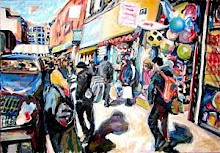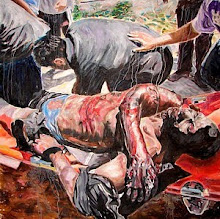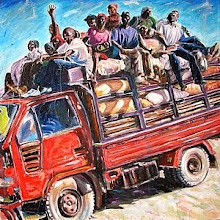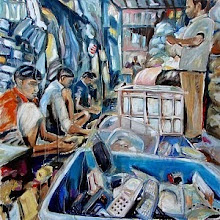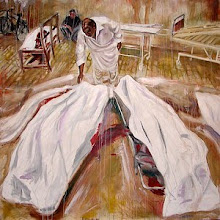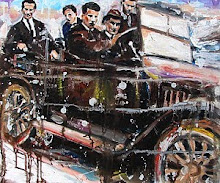During a recent tour in Brazil, I visited the Rocinha
Favela in Rio de Janeiro. Rocinha is the largest favela in Brazil and
runs up a very steep hill near the centre of Rio. It is believed at
least 70,000 people live in Rocinha (some estimates suggest more than
double that number), living in houses made from concrete and brick. It
is officially described as a neighbourhood and has very basic
sanitation, plumbing and electricity. Rocinha also has shops,
hairdressers, banks, art galleries and many other businesses. The word
favela itself is derived from a skin-irritating plant of the spurge
family: removing these plants to live in these areas was not easy so the
people called the hills after the plant.
View of sea from top of Rocinha favela (Caoimhghin Ó Croidheáin 2018)
History
The favelas go back to the late 1800s when soldiers, brought in for a local war, had no place to live and so settled in the hills. After the end of slavery and the growth of city life many people moved to the cities and the favelas spread. A later industrialisation drive in the 1940s brought many more people to the cities and the favelas expanded dramatically. In the 1970s there were public housing projects but these too disintegrated into new favelas. As the drugs trade increased in the 1980s so too did the growth of gangs and gang warfare. In Rocinha, like many slums, it also has an ongoing conflict between police and drug dealers.
Locals perform samba drumming, Rocinha (Caoimhghin Ó Croidheáin 2018)
UPP and BOPE
The state began a war on the drug gangs in 2008 with the Pacifying Police Units (UPP) moving in, usually after an initial operation by BOPE (Special Police Operations Battalion) who scour the area for heavy weapons and drug caches. The main purpose of the UPP is to stop armed men from ruling the streets and end drug trafficking. However, there seems to be an uneasy peace between the UPP and the drug gangs. While walking through the narrow 'streets' of Rocinha, a man with a revolver pointed in the air walked through our group and twice we were asked to refrain from taking photographs as we walked past armed groups of men.
Cemented-over bullet holes, Rocinha (Caoimhghin Ó Croidheáin 2018)
Cinema
If you look at any listicle of Brazil's best films you will probably see two films, Elite Squad (2007) and Elite Squad: The Enemy Within (2010) contained within. These films follow the actions of a BOPE squad in a the favelas and does so without pulling any punches. Different, conflicting elements of society are portrayed in both Elite Squad films. The BOPE and police are shown to have corrupt elements, ultimately manipulated by political figures. The middle class are shown in the discussions about the nature of power in university lectures (with particular emphasis on Michel Foucault) and the students are shown working in charitable organisations in the favelas with the nod from drug gang leaders. The main narrative of the films is the idea of corrupt police making financial deals with the drugs gangs - Elite Squad (2007), and changing to corrupt politicians making money by taxing the whole community after the drug gangs have been pushed out - Elite Squad: The Enemy Within (2010).
If you look at any listicle of Brazil's best films you will probably see two films, Elite Squad (2007) and Elite Squad: The Enemy Within (2010) contained within. These films follow the actions of a BOPE squad in a the favelas and does so without pulling any punches. Different, conflicting elements of society are portrayed in both Elite Squad films. The BOPE and police are shown to have corrupt elements, ultimately manipulated by political figures. The middle class are shown in the discussions about the nature of power in university lectures (with particular emphasis on Michel Foucault) and the students are shown working in charitable organisations in the favelas with the nod from drug gang leaders. The main narrative of the films is the idea of corrupt police making financial deals with the drugs gangs - Elite Squad (2007), and changing to corrupt politicians making money by taxing the whole community after the drug gangs have been pushed out - Elite Squad: The Enemy Within (2010).
Overhanging wires on telegraph poles, Rocinha (Caoimhghin Ó Croidheáin 2018)
Tourism
The global success of these two films have probably been one of the factors in encouraging tourism in the favelas While the drug gangs generally do not appear to target tourists there have been incidents where tourists have been injured or killed by both the police and the drug gangs usually as the result of some accident or misunderstanding. In general, tourism, like in many other places, is a quick-fix solution for local businesses but does little in the way of any real social or economic development of the favela neighbourhoods.
The global success of these two films have probably been one of the factors in encouraging tourism in the favelas While the drug gangs generally do not appear to target tourists there have been incidents where tourists have been injured or killed by both the police and the drug gangs usually as the result of some accident or misunderstanding. In general, tourism, like in many other places, is a quick-fix solution for local businesses but does little in the way of any real social or economic development of the favela neighbourhoods.
Local store, Rocinha (Caoimhghin Ó Croidheáin 2018)
Whither the favelas?
While slums became common in Europe and the USA in the 19th and 20th centuries they are predominantly found in developing countries today. The Little Ireland slum in Manchester, for example, became a source for social scientist Friedrich Engels' book titled The Condition of the Working Class in England published in Germany in 1845. According to the UN World Cities Report 2016: Urbanization and Development - Emerging Futures:
While slums became common in Europe and the USA in the 19th and 20th centuries they are predominantly found in developing countries today. The Little Ireland slum in Manchester, for example, became a source for social scientist Friedrich Engels' book titled The Condition of the Working Class in England published in Germany in 1845. According to the UN World Cities Report 2016: Urbanization and Development - Emerging Futures:
"The
percentage of slum dwellers in urban areas across all developing
regions has reduced considerably since 1990, but the numbers have
increased gradually since 2000 except for a steep rise of 72 million new
slum dwellers in sub-saharan Africa."
Also, according to one article on the world's five biggest slums:
"Around a quarter of the world’s urban population lives in slums. And this figure is rising fast. The number of slum dwellers in developing countries increased from 689 million in 1990 to 880 million in 2014, according to the United Nations World Cities Report 2016."The biggest slums in the world today are: Khayelitsha, Cape Town, South Africa (Population: 400,000), Kibera, Nairobi, Kenya (Population: 700,000), Dharavi, Mumbai, India (Population: 1 million), Ciudad Neza, Mexico City, Mexico (Population: 12 million), and Orangi Town, Karachi, Pakistan (Population: 2.4 million).
Also, according to one article on the world's five biggest slums:
"Around a quarter of the world’s urban population lives in slums. And this figure is rising fast. The number of slum dwellers in developing countries increased from 689 million in 1990 to 880 million in 2014, according to the United Nations World Cities Report 2016."The biggest slums in the world today are: Khayelitsha, Cape Town, South Africa (Population: 400,000), Kibera, Nairobi, Kenya (Population: 700,000), Dharavi, Mumbai, India (Population: 1 million), Ciudad Neza, Mexico City, Mexico (Population: 12 million), and Orangi Town, Karachi, Pakistan (Population: 2.4 million).
Favela mural, Rocinha (Caoimhghin Ó Croidheáin 2018)
Urbanisation and the flight from the landThe development of industrialised farming has been one of the major reasons for the the flight from the land. There is also the perceived view that economic opportunities are greater in the cities. Governments invest less in rural communities because of lower population densities and this creates a vicious cycle In Ireland today, for example, friends of mine in rural areas still can't get broadband speeds fast enough to play video clips on their computers and in August the government announced the closure of over 160 post offices nationwide. Meanwhile the urbanisation of Dublin has extended into neighbouring counties while pubs and shops in the rural areas close due to a lack of footfall. While the pressure on Dublin has not produced slums it has created huge increases in rents and a growing homelessness problem.
So what can be done about slums? There appears to be three main approaches to the question of the future of slums around the world today: (1) Renovation: top-down and bottom-up approaches, (2) Demolition for rehousing and rebuilding, and (3) Demolition for parkland.
Local bakery, Rocinha (Caoimhghin Ó Croidheáin 2018)
Renovation: top-down and bottom-up approaches
Around the world slum upgrading has consisted of concrete paths, sanitation, safe drinking water, water drainage systems and public transport. The Brazilian state has done some top-down upgrading in the favelas putting in basic sanitation and social services but much more needs to be done with masses of wires on telegraph poles and cabling bundled along the side of the paths. However, with the global neo-liberal move towards privatisation of public housing there doesn't seem to be much hope for governments doing serious renovation of slums in the near future. More importantly, in my opinion, has been the bottom-up slum upgrading, for example, in Orangi Town, Karachi in Pakistan where the residents installed sewers in 90% of 8,000 streets and lanes, digging them by hand themselves. This kind of community spirit builds solidarity which is more important for the residents in the long run in their struggle against uncaring states:
Around the world slum upgrading has consisted of concrete paths, sanitation, safe drinking water, water drainage systems and public transport. The Brazilian state has done some top-down upgrading in the favelas putting in basic sanitation and social services but much more needs to be done with masses of wires on telegraph poles and cabling bundled along the side of the paths. However, with the global neo-liberal move towards privatisation of public housing there doesn't seem to be much hope for governments doing serious renovation of slums in the near future. More importantly, in my opinion, has been the bottom-up slum upgrading, for example, in Orangi Town, Karachi in Pakistan where the residents installed sewers in 90% of 8,000 streets and lanes, digging them by hand themselves. This kind of community spirit builds solidarity which is more important for the residents in the long run in their struggle against uncaring states:
"In
1980, the development expert and entrepreneur, Akhtar Hameed Khan,
observed how many communities were self-organising to fill the gap in
services - from building homes and schools to water delivery - and
launched the Orangi Pilot Project (OPP). Now globally renowned, the
project has not only led the DIY sewerage projects which continue to
expand to this day, but has built a network to manage a plethora of
programmes that range from micro credit to water supply, to women's
savings schemes. OPP's director Saleem Aleemuddin told the Thomson
Reuters Foundation that when activists began working in the area in
1980, the lack of sanitation was the most "obvious" and "problematic"
area for residents. While it took the OPP around six months to convince
local residents to invest and pay for the installation of the first
sewerage line on their street, it was not long before people were taking
their lead and organising themselves. "Since the government gets almost
nothing in revenue from the slum, it therefore pays the least interest
to its [slum] developments too," Aleemuddin said. "In fact, people in
the town now consider the streets as part of their homes because they
have invested in them and that's why they maintain and clean the sewers
too.""
Favela houses, Rocinha (Caoimhghin Ó Croidheáin 2018)
Others argue that the slums should be seen as similar to the medieval towns and parts of cities preserved all over Europe:
"The tight-knit structure of settlements built in the Middle Ages serves as an important lesson on making modern developments compact and keeping key services easily accessible to the people using them."
Thus, they argue, slums could be converted into a form of green, eco-friendly living areas such as Cambridge where people walk everywhere now instead of driving. However, it is more likely to become a form of gentrification as usually it is wealthier people who can afford to do the extensive and detailed building and repairs (not to mention the demands of state preservation policies in the case of medieval buildings).
"The tight-knit structure of settlements built in the Middle Ages serves as an important lesson on making modern developments compact and keeping key services easily accessible to the people using them."
Thus, they argue, slums could be converted into a form of green, eco-friendly living areas such as Cambridge where people walk everywhere now instead of driving. However, it is more likely to become a form of gentrification as usually it is wealthier people who can afford to do the extensive and detailed building and repairs (not to mention the demands of state preservation policies in the case of medieval buildings).
Government plans for Rocinha (Caoimhghin Ó Croidheáin 2018)
Demolition for rehousing and rebuilding
The demolition of slums for rehousing projects does not have a great history. It tended to shift the social problems of the slums to other parts of the city. In Ireland in the 1960s, Dublin's slums had reached a breaking point as urbanisation and the collapse of slum houses put pressure on the government to move people out to suburban Ballymun into high-rise 15-storey flat complexes. However, by the 1980s Ballymun was seen as a social sink and had to be regenerated itself in the 2000s and the blocks demolished. Also, this strategy can be a cynical ploy as the flats built on the sites of the former slums are sold as properties on high-value city-centre land
The demolition of slums for rehousing projects does not have a great history. It tended to shift the social problems of the slums to other parts of the city. In Ireland in the 1960s, Dublin's slums had reached a breaking point as urbanisation and the collapse of slum houses put pressure on the government to move people out to suburban Ballymun into high-rise 15-storey flat complexes. However, by the 1980s Ballymun was seen as a social sink and had to be regenerated itself in the 2000s and the blocks demolished. Also, this strategy can be a cynical ploy as the flats built on the sites of the former slums are sold as properties on high-value city-centre land
Local kindergarten,Rocinha (Caoimhghin Ó Croidheáin 2018)
Demolition for parkland
A prime example of a slum demolition is the Kowloon Walled City in Hong Kong which eventually became the Kowloon Walled City Park. What started off as a Chinese military fort in the 1800s became one of the most densely populated slums in the world. It was extended upwards in the 1960s to become a city of over 30,000 people in 300 buildings occupying little more than 7 acres (2.8 ha). The residents were compensated (with some being forcibly evicted) and demolition was concluded in 1994. Today it is a 31,000 m2 (330,000 sq ft) park which was completed in August 1995.
In Brazil, this is always a possible future for the favelas in Rio. Not many realise that the sculpture of Christ the Redeemer on top of Corcovado mountain is in the middle of the Tijuca Forest - a massive reclamation project of land which had suffered from erosion and deforestation caused by intensive farming of sugar and coffee in the nineteenth century. The whole area was replanted with plants and trees of the rainforest and is one of the biggest urban forests in the world today.
A prime example of a slum demolition is the Kowloon Walled City in Hong Kong which eventually became the Kowloon Walled City Park. What started off as a Chinese military fort in the 1800s became one of the most densely populated slums in the world. It was extended upwards in the 1960s to become a city of over 30,000 people in 300 buildings occupying little more than 7 acres (2.8 ha). The residents were compensated (with some being forcibly evicted) and demolition was concluded in 1994. Today it is a 31,000 m2 (330,000 sq ft) park which was completed in August 1995.
In Brazil, this is always a possible future for the favelas in Rio. Not many realise that the sculpture of Christ the Redeemer on top of Corcovado mountain is in the middle of the Tijuca Forest - a massive reclamation project of land which had suffered from erosion and deforestation caused by intensive farming of sugar and coffee in the nineteenth century. The whole area was replanted with plants and trees of the rainforest and is one of the biggest urban forests in the world today.
Cabling on streets, Rocinha (Caoimhghin Ó Croidheáin 2018)
Climate change and the future of urbanism
The future of slums around the world seems tied to a kind of trendy belief in the necessity of planning for an urban future. However, there are those that believe that an alternative to the constant growing urbanisation is to create a model that would attract a part of the urban population back to the rural environment. The potential for creating jobs in the agricultural sector in the future must be seen in the context of sustainable soil management and the difficulties that will be facing food production in future projected changes in temperature, ultraviolet radiation, soil moisture and pests which are expected to decrease food production.
Governments would be better off to develop projects to modernise the rural areas with the type of facilities and services that can be obtained in the cities to attract people back to the land. Collapses in various crops or crop destruction around the world due to unexpected frosts, drought, hurricanes, floods etc can only be expected to increase, leading to food insecurity and the potential for global food price increases and food riots.
Malcolm X mural, Rocinha (Caoimhghin Ó Croidheáin 2018)
The
very existence of a slum shows a government's inability or reluctance
to deal with mass population shifts. It reveals a fundamental structural
problem in democratic processes and redistribution of tax wealth. For a
government to allow a section its own citizens to live a Hobbesian
existence exposes the rhetoric of a government for all. How can this be
changed and slum issues be resolved? As the Orangi Town example above
shows, solidarity and activism can solve practical problems efficiently
even if it is letting the government off the hook of responsibility. As
has been seen in the past, the social contract only operates when both
government and people keep their sides of the bargain. When or if it
breaks down the anger constantly bubbling underneath can spill over.
While revolutionary changes around the world in the past, in general,
are often attributed to their great leaders, the fact is that it is
usually down to the most expropriated and alienated people in society to
get the great social change juggernaut moving in the first place.
All images in this article are from the author.
Caoimhghin Ó Croidheáin is an Irish artist, lecturer and writer. His artwork
consists of paintings based on contemporary geopolitical themes as well
as Irish history and cityscapes of Dublin. His blog of critical writing
based on cinema, art and politics along with research on a database of
Realist and Social Realist art from around the world can be viewed
country by country here. He is a Research Associate of the Centre for Research on Globalization.
